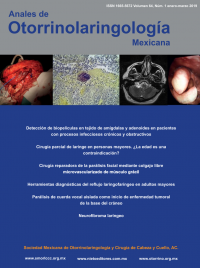Standardization of the technique of transoperatory neural monitoring of the recurrent laryngeal nerve.
An Orl Mex. 2018 abril-junio;63(2):59-67.
Jorge Alberto Romo-Magdaleno, Carmen Gabriela Torres-Alarcón, Adelaido López-Chavira, Moisés Albino Pacheco-Ramírez, Cesar Gamaliel Rivera-Martínez, Alejandro Saúl Moreno-Reynoso, Oscar Omar Mateos-Aguilar
Servicio de Otorrinolaringología y Cirugía de Cabeza y Cuello, Hospital Central Militar, Ciudad de México.
Resumen
ANTECEDENTES: El patrón de referencia para evitar la lesión del nervio laríngeo recurrente es la visualización directa y el monitoreo se diseñó para facilitar la identificación y valorar el estado funcional del nervio durante la cirugía.
OBJETIVO: Conocer el número y tipo de errores en la técnica de neuromonitoreo del nervio laríngeo recurrente.
MATERIAL Y MÉTODO: Estudio prospectivo, transversal, descriptivo y observacional, en el que se incluyeron pacientes a los que se les practicó cirugía tiroidea durante el periodo de agosto a octubre de 2016. La evaluación prospectiva de los pacientes consistió en monitorear el nervio laríngeo recurrente con el sistema de integridad nerviosa NIM 3.0, Medtronic Xomed®, posterior a la identificación visual del nervio laríngeo superior y vago. Los datos se analizaron con el programa estadístico SPSS Statistics 21.
RESULTADOS: Se incluyeron 34 nervios en riesgo; se monitorearon 44.1% de los nervios laríngeos recurrentes en riesgo con éxito. El error identificado de mayor frecuencia fue la ausencia del registro de la intensidad de la onda en el paso V1 en 35.1% de los nervios laríngeos recurrentes en riesgo, seguido de la intensidad de la onda en V2 en 32.4%; administración de relajante muscular en 14.7% y la colocación inadecuada de los electrodos en 11.8%. Hubo 6 casos de parálisis cordal, con pérdida de señal en 5 de ellos y un falso negativo, el valor predictivo positivo fue de 62.5% y el valor predictivo negativo de 96.1%.
PALABRAS CLAVE: Nervio laríngeo recurrente; cirugía tiroidea; tiroidectomía.
Abstract
BACKGROUND: The reference pattern to avoid recurrent laryngeal nerve injury is direct visualization and monitoring was designed to facilitate identification and assess the functional status of the nerve during surgery.
OBJECTIVE: To know the number and type of errors in the technique of neuromonitoring of the recurrent laryngeal nerve.
MATERIAL AND METHOD: A prospective, cross-sectional, descriptive and observational study was done in which patients undergoing thyroid surgery were included during the period from August to October 2016. The prospective evaluation of the patients consisted in monitoring the recurrent laryngeal nerve with the nerve integrity system NIM 3.0, Medtronic Xomed®, after the visual identification of the upper laryngeal nerve and vagus nerve. The data was analyzed with the statistical program SPSS Statistics 21.
RESULTS: There were included 34 nerves in risk; 44.1% of the recurrent laryngeal nerves at risk were successfully monitored. The most frequently identified error was the absence of recording the intensity of the wave in step V1 in 35.1% of the recurrent laryngeal nerves at risk, followed by the wave intensity in V2 in 32.4%; administration of muscle relaxant in 14.7% and inadequate placement of the electrodes in 11.8%. There were 6 cases of chordal paralysis, with loss of signal in 5 of them and a false negative, the positive predictive value was 62.5% and the negative predictive value of 96.1%.
KEYWORDS: Recurrent laryngeal nerve; Thyroid surgery; Thyroidectomy.


